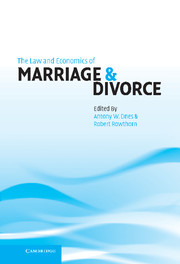Book contents
- Frontmatter
- Contents
- List of tables and figure
- List of contributors
- 1 Introduction
- 2 Marriage: the long-term contract
- 3 Marital commitment and the legal regulation of divorce
- 4 Mutual consent divorce
- 5 An economic approach to adultery law
- 6 Louisiana's covenant marriage law: recapturing the meaning of marriage for the sake of the children
- 7 Cohabitation and marriage
- 8 Marriage as a signal
- 9 For better or for worse? Is bargaining in marriage and divorce efficient?
- 10 Weak men and disorderly women: divorce and the division of labor
- 11 The impact of legal reforms on marriage and divorce
- 12 European divorce laws, divorce rates, and their consequences
- Index
- References
11 - The impact of legal reforms on marriage and divorce
Published online by Cambridge University Press: 13 August 2009
- Frontmatter
- Contents
- List of tables and figure
- List of contributors
- 1 Introduction
- 2 Marriage: the long-term contract
- 3 Marital commitment and the legal regulation of divorce
- 4 Mutual consent divorce
- 5 An economic approach to adultery law
- 6 Louisiana's covenant marriage law: recapturing the meaning of marriage for the sake of the children
- 7 Cohabitation and marriage
- 8 Marriage as a signal
- 9 For better or for worse? Is bargaining in marriage and divorce efficient?
- 10 Weak men and disorderly women: divorce and the division of labor
- 11 The impact of legal reforms on marriage and divorce
- 12 European divorce laws, divorce rates, and their consequences
- Index
- References
Summary
Introduction
With several countries currently reconsidering the status of their existing marriage and divorce legislation, there has begun an increased interest in the “facts” regarding the actual impact of laws on marriage and divorce behavior. For those interested in a simple answer, a simple perusal of the economic literature will not be very satisfactory. There, some argue that the law merely reflects the social norms of the time, and is impotent in changing any behavior. Others argue that the law is critical in establishing the constraints and threat points that couples bargain under, and therefore the laws do influence behavior. Presumably an empirical analysis of these issues could settle this dispute, but unfortunately, though the questions are relatively straightforward, the answers seem very difficult to pin down. Furthermore, although the effect of marriage laws must filter into all types of household decisions – from the choice of living together or becoming married, to the choice over what career path to take – almost all of the academic attention has been devoted to the effect of no-fault divorce laws on the divorce rate, with relatively minor attention paid to female labor force participation.
When it comes to marriage law, as detailed as that subject is, most people simply mean the no-fault divorce laws that swept the Western world in the early 1970s.
- Type
- Chapter
- Information
- The Law and Economics of Marriage and Divorce , pp. 191 - 211Publisher: Cambridge University PressPrint publication year: 2002
References
- 7
- Cited by



